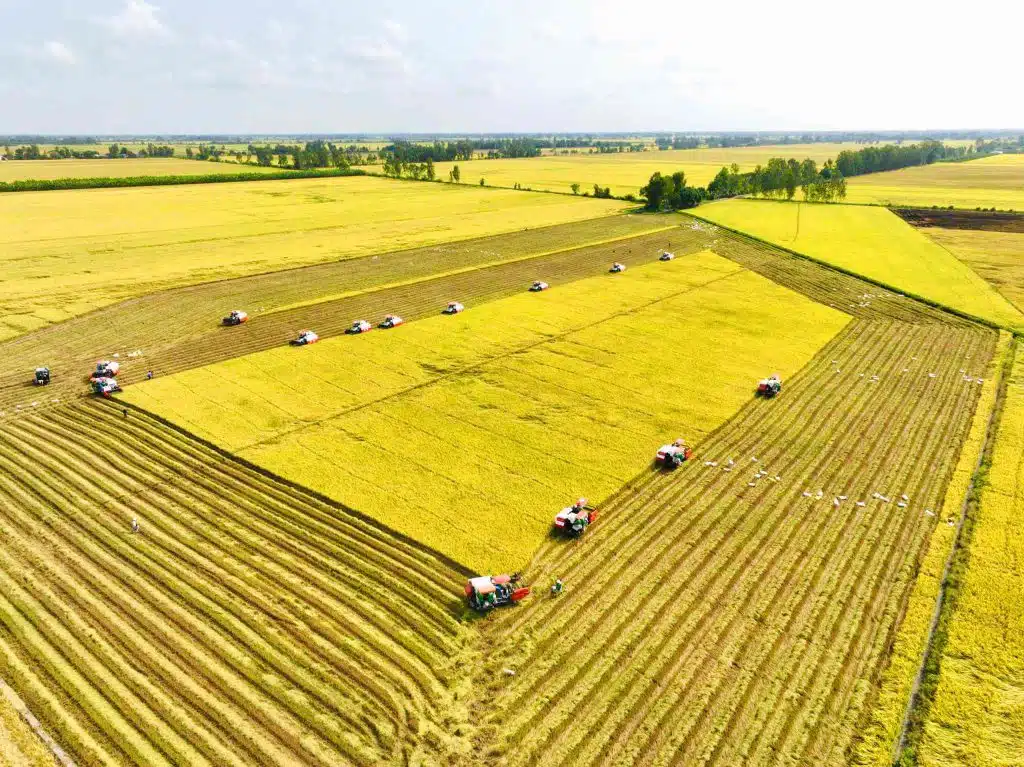Story: Le Hoang Vu
Photos: Le Hoang Vu, Dao Canh
In coming years, Vietnamese rice farmers could earn hundreds of millions of USD in addition to their revenues from rice sales by applying green cultivation.
In his 2008 book Hot, Flat, and Crowded: Why We Need a Green Revolution, the Pulitzer Prize–winning journalist Thomas Friedman cited studies and scientists from the U.S. Environmental Protection Agency (EPA) on greenhouse gas emissions from agriculture, stating that “a cow emits about 600 liters of methane per day”, and with “1.3 billion cows burping” simultaneously, we can easily imagine the scale of emissions generated by agriculture.
Friedman used cows as an example because the U.S. consumes a lot of beef products. However, it’s not just cattle farming; other agricultural activities, such as rice cultivation also emit massive amounts of greenhouse gases.

2022 data from the Ministry of Agriculture and Rural Development (now the Ministry of Agriculture and Environment – MARD) shows that agriculture accounted for about 30% of the country’s total greenhouse gas emissions. Agricultural emissions are concentrated in three main areas: rice farming (49.7 million tons of CO2, accounting for 50%), livestock (18.5 million tons of CO2, 19%), and land management and fertilizer use (13.2 million tons of CO2, 13%).
According to the World Bank (WB), rice cultivation in Vietnam emits nearly 50 million tons of greenhouse gases annually, meaning that producing 0.9 tons of rice generates one ton of CO2 equivalent. Vietnam’s rice farming emits more greenhouse gases than this sector in China and India, ranking fifth among the world’s top 10 rice–exporting countries.
The “Sustainable Development of 1 Million Hectares of High–Quality, Low–Emission Rice Cultivation Linked to Green Growth in the Mekong Delta by 2030” project (commonly referred to as the “1 Million Hectares Project”), led by MARD and implemented in Vietnam’s southwestern provinces, aims to reduce greenhouse gas emissions and promote sustainable farming to adapt to climate change. This will improve production efficiency, income, and the living standards of rice farmers. Prime Minister Pham Minh Chinh affirmed that this is a “revolution for rice cultivation” aimed at enhancing the value of the rice industry, increasing farmers’ income, and reducing greenhouse gas emissions, working towards the goal of net–zero emissions as committed at the COP26 conference.
A project with multiple benefits
Rice farming generates significant greenhouse gases, but without it, global food security would be at risk. To ensure farmer participation, emission reduction efforts must also provide direct benefits to them. The Agricultural Service Center of Can Tho City reported that the project’s implementation in Can Tho has reduced seed usage from 120 – 150 kg/ha to 60 – 70 kg/ha, optimized fertilizer use, and improved pest management, enhancing rice quality. Estimates suggest that the 1 Million Hectares Project could lower production costs by about 20%, saving approximately VND 9.5 trillion per year for the projected 13 million tons of rice by 2030.
Costs have decreased while yields have risen. Pilot results at Tien Dung Agricultural Cooperative in Thanh Phu commune, Co Do district, Can Tho, show rice yields of 8.88 – 9.5 tons/ha, exceeding traditional models by 0.1 – 0.72 tons/ha. Farmers’ profits rose by VND 5.19 – 8.96 million/ha, with net earnings of about VND 30 million/ha after deducting costs.

In addition to lower cultivation costs and higher yields, adopting sustainable farming practices could increase rice prices by about 10%, generating over VND 7 trillion annually by 2030.
Agricultural extension is the key to success
The benefits of low–emission rice farming are significant, but farmers’ awareness, participation, and success depend on the crucial support of the agricultural extension system.
“The success or failure of any revolution depends on the human factor,” said Mr. Le Minh Hoan, Vice Chairman of the National Assembly and former Minister of MARD. “The new revolution in the fields depends on the farmers. Who stands beside the farmers in the furrows? It is the agricultural extension force, from central to community levels. This is the time for the agricultural extension team to demonstrate their role as friends, companions, and advocates for farmers.”
Grassroots agricultural extension systems and community extension groups have made decisive contributions, supporting farmers in adopting advanced rice farming techniques to reduce greenhouse gas emissions and improve economic efficiency.
In many localities, community extension groups have directly helped farmers to apply technical advancements such as the “1 must do, 5 reductions” method, Integrated Pest Management (IPM), alternate wetting and drying irrigation, and mechanization in rice production and harvesting. These models reduce production costs and improve the quality of agricultural products, paving the way for sustainable development in Vietnam’s rice industry.
According to the An Giang Agricultural Extension Center, the use of biotechnology and modern water management techniques has helped hundreds of households improve production efficiency while minimizing environmental impact.
Agricultural extension goes beyond transferring techniques – it supports farmers throughout the production process. Working alongside research institutes and experts, the extension system offers scientific solutions to reduce input materials, labor, and emissions while enhancing productivity, quality, and, importantly, farmers’ health.
High–quality, low–emission rice production models are yielding higher profits for farmers in the Mekong Delta. This success is motivating the model’s expansion toward a goal of sustainable rice production, meeting domestic and export market demands.
Mr. Le Quoc Thanh, Director of the National Agricultural Extension Center, praised the project’s effectiveness and emphasized the value of its nationwide implementation: “The sustainable development of one million hectares of high–quality rice should not be limited to the Mekong Delta but expanded nationwide. The National Agricultural Extension Center will continue to accompany farmers, providing technical support, training, and modern farming solutions, aiming for green, sustainable, and efficient agriculture.”










